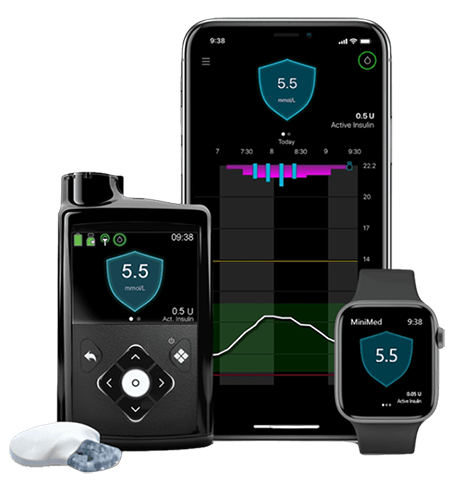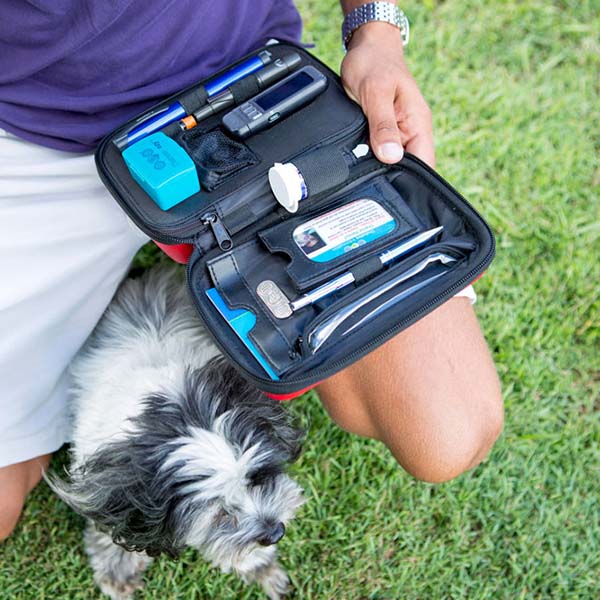An insulin pump is a small electronic device, about 5.3cm wide and 9.6cm tall. The pump can help you mimic the way a healthy pancreas functions, replacing the need for frequent injections. The pump delivers precise doses of rapid-acting insulin 24 hours a day, to match your body's needs.

Basal rate
Small amounts of insulin released continuously throughout the day to mimic the background insulin production of the pancreas.
Bolus rate
Additional insulin can be delivered “on-demand" to match the food you are going to eat or to correct high blood sugar.
Components of insulin pump therapy
Infusion set
An infusion set includes a thin cannula that goes from the reservoir to the infusion site on your body. The cannula is inserted into the site -similar to where you would give insulin injections. The infusion set is changed every two to three days
Insulin pump
A small, durable electronic device to program your insulin and show you how you are tracking. The device includes a reservoir compartment
Reservoir
A plastic cartridge that holds the insulin and is locked into the insulin pump. A reservoir can hold up to 300 units of insulin and is changed every two to three days
How small is an insulin pump?
The MiniMed™ 780G insulin pump is about the size of a mobile phone.
It weighs about 100 grams, not including the battery. This allows the pump to be discreetly carried on a belt, inside a pocket or even attached to a bra.
Shop online

You improve by using additional components:
Blood Glucose Meter
Wirelessly transmits your BG readings to your pump.Continuous Glucose Monitoring
A transmitter and sensor your glucose readings to your pump, giving you early warnings of highs and lows, lowering HbA1c levels1 and reducing the time of hypos.2CareLink™ Software
An online tool allowing you to track your insulin usage and its levels during your daily activities.What are the benefits of insulin pump therapy?
Insulin pump therapy offers clinical benefits over multiple daily injection therapy.
Improve Glucose Control3
With our pump and sensor system, you’re four times more likely to reach your target A1C4. You can also reduce low glucose episodes by up to 84 percent and lower the risk of long-term complications.5,6
90% Fewer Injections*

Kidney damage reduced up to 54%6

Cardiovascular damage reduced up to 41%6

Nerve damage reduced up to 60%6

Eye damage reduced up to 63%6

Lower HbA1c7, 8

Fewer hypoglycaemic events2

Easier dosing, accurate dosing, no needles9, 10

Greater flexibility in when to eat and how to exercise9, 10
Talk to a diabetes therapy consultant today.
Request a call today to discuss the benefits of insulin pump therapy with a Medtronic Diabetes Therapy Consultant.
ALWAYS FOLLOW THE DIRECTIONS FOR USE.
For detailed information regarding indications, contraindications, warnings, precautions, and
potential adverse effects, please consult the IFU. Always consult a Health Care Professional before
making treatment decisions, and to see if this product is suitable for you.
References
* Assumes four injections per day for 30 days and one infusion set change every three days.
1. Kaufman FR, et al. A pilot study of continuous glucose monitoring system. Diab Care.
2001:24:2030-2034
2. User Evaluations. Data on File, Medtronic MiniMed, Inc., Northridge, CA
3. Battelino T, Conget I, Olsen B, et al. The use and efficacy of continuous glucose monitoring in
Type 1 diabetes treated with insulin pump therapy: a randomized controlled trial. Diabetologia.
2012;55:3155–3162.
4. Doyle EA, Weinzimer SA, Steffen AT, Ahern JAH, Vincent M, Tamborlane WV. A randomized prospective
trial comparing the efficacy of insulin pump therapy with multiple daily injections using insulin
glargine. Diabetes Care. 2004;27(7):1554–1558.
5. Bode BW, Steed RD, Davidson PC. Reduction in severe hypoglycemia with long-term continuous
subcutaneous insulin infusion in Type 1 diabetes. Diabetes Care. 1996;19:324–327.
6. The Diabetes Control and Complications Trial Research Group. The effect of intensive treatment of
diabetes on the development and progression of long-term complications in insulin-dependent diabetes
mellitus. N Engl J Med. 1993;329:977–986.
7. J. C. Pickup and A. J. Sutton Severe hypoglycaemia and glycemic control in Insulin Dependant
Diabetes: meta-analysis of multiple daily insulin injections compared with continuous subcutaneous
insulin infusion Diabetic Medicine 2008 :25, 765–774.
8.Bergenstal RM1, Tamborlane WV, Ahmann A, Buse JB, Dailey G, Davis SN, Joyce C, Perkins BA, 3.
Welsh JB, Willi SM, Wood MA; STAR 3 Study Group. Sensor-augmented pump therapy for A1C reduction
(STAR 3) study: results from the 6-month continuation phase. Diabetes Care. 2011 Nov;34(11):2403-5.
doi: 10.2337/dc11-1248. Epub 2011 Sep 20.
12682-052023 ©2023 Medtronic. All rights reserved Medtronic.
